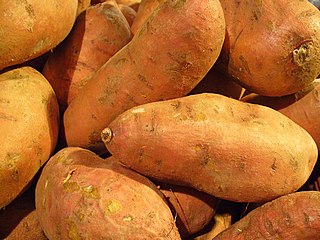
The sweet potato is a dicotyledonous plant that belongs to the bindweed or morning glory family, Convolvulaceae. Its large, starchy, sweet-tasting tuberous roots are used as a root vegetable. The young shoots and leaves are sometimes eaten as greens. Cultivars of the sweet potato have been bred to bear tubers with flesh and skin of various colors. Sweet potato is only distantly related to the common potato, both being in the order Solanales. Although darker sweet potatoes are often referred to as "yams" in parts of North America, the species is even more distant from the true yams, which are monocots in the order Dioscoreales.

The chestnuts are the deciduous trees and shrubs in the genus Castanea, in the beech family Fagaceae. The name also refers to the edible nuts they produce. They are native to temperate regions of the Northern Hemisphere.

A fritter is a portion of meat, seafood, fruit, vegetables, or other ingredients which have been battered or breaded, or just a portion of dough without further ingredients, that is deep-fried. Fritters are prepared in both sweet and savory varieties.

Corn on the cob is a culinary term for a cooked ear of sweet corn (maize) eaten directly off the cob. The ear is picked while the endosperm is in the "milk stage" so that the kernels are still tender. Ears of corn are steamed, boiled, or grilled usually without their green husks, or roasted with them. The husk leaves are removed before serving.
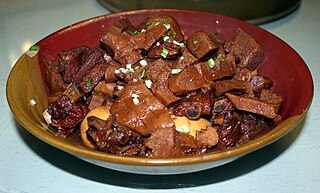
Shandong cuisine, more commonly known in Chinese as Lu cuisine, is one of the Eight Culinary Traditions of Chinese cuisine and one of the Four Great Traditions. It is derived from the native cooking style of Shandong Province, a northern coastal province of China.

Roast goose is cooking goose meat using dry heat with hot air enveloping it evenly on all sides. Many varieties of roast goose appear in cuisines around the world, including Cantonese, European, and Middle Eastern cuisines. Roasting can enhance its flavor.

In Vietnamese, the term bánh translates loosely as "cake" or "bread", but refers to a wide variety of prepared foods that can easily be eaten by hands or chopsticks. With the addition of qualifying adjectives, bánh refers to a wide variety of sweet or savory, distinct cakes, buns, pastries, sandwiches, and other food items, which may be cooked by steaming, baking, frying, deep-frying, or boiling. Foods made from wheat flour or rice flour are generally called bánh, but the term may also refer to certain varieties of noodle and fish cake dishes, such as bánh canh and bánh hỏi.

Hotteok, sometimes called hoeddeok, is a type of filled pancake known as a popular street food in South Korea. It originated in China, and was first brought into Korea during the 19th century.

Chè is any traditional Vietnamese sweet beverage, dessert soup or stew, or pudding. Chè includes a wide variety of distinct soups or puddings. Varieties of Chè can be made with mung beans, black-eyed peas, kidney beans, tapioca, jelly, fruit, and coconut cream. Other types are made with ingredients such as salt, aloe vera, seaweed, lotus seed, sesame seed, sugar palm seeds, taro, cassava and pandan leaf extract. Some varieties, such as chè trôi nước, may also include dumplings. Chè are often prepared with one of a number of varieties of beans, tubers, and/or glutinous rice, cooked in water and sweetened with sugar. In southern Vietnam, chè are often garnished with coconut creme.
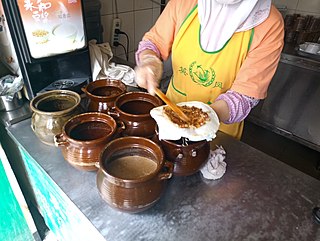
Erkuai is a type of rice cake particular to the Yunnan Province of southwest China.

A great variety of cassava-based dishes are consumed in the regions where cassava is cultivated.

Castañada, Magosta, Magosto or Magusto, is a traditional festival on the Iberian Peninsula. It is popular in Portugal, Galicia and some areas of northern Spain, such as Cantabria, Asturias, Catalonia, and the provinces of León, Zamora and Salamanca and Cáceres, but also in some parts of the Canary Islands. The festival is also celebrated in both sides of the French-Spanish border. It has also spread internationally as a 'chestnut party'. Etymological origins are unknown, but there are several theories for the Magosto name: Magnus Ustus or Magum Ustum.

Regional street food is street food that has commonalities within a region or culture.
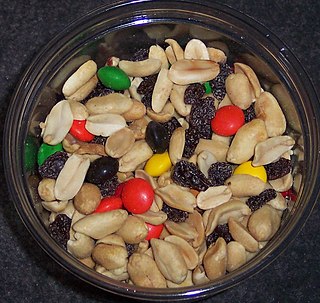
A snack is a small portion of food generally eaten between meals. A snack is often less than 200 calories, but this can vary. Snacks come in a variety of forms including packaged snack foods and other processed foods, as well as items made from fresh ingredients at home.
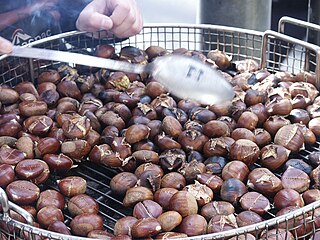
Roasted chestnut is a popular autumn and winter street food in East Asia, Europe, and New York City. Asian chestnuts as well as European chestnuts can be used.
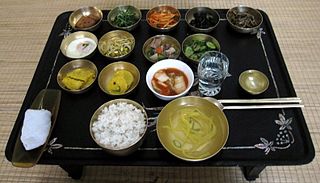
North Korean cuisine is the traditional culinary practices and dishes of North Korea. Its foundations are laid by the agricultural and nomadic traditions in southern Manchuria and the Korean Peninsula. Some dishes are shared by the two Koreas; however, availability and quality of Northern cuisine is much more significantly affected by sociopolitical class divides.

Hoshiimo (干し芋) is a sweet potato snack popular in Japan similar to a number of other dried foods in Asia. This food generally consists of steamed, dried, sweet potatoes that are skinned and sliced with no artificial sweeteners added. In some cases, the sweet potatoes may be roasted rather than steamed. The surface may be covered with a white powder. Not to be mistaken for mold, this is a form of crystallized sugar that emerges as the sweet potatoes dry. With a chewy texture and sweet potato flavor, this food can be eaten raw or roasted. This dish is particularly rich in vitamins A, B1, C, and E and contains much potassium and calcium as well as dietary fiber. As an alkaline food, reputedly it helps the body maintain a healthy pH balance.

























